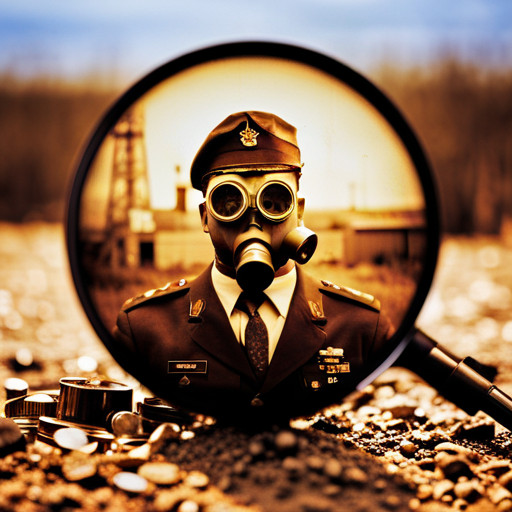Protecting the Rights of Victims in Military Pollution Scenarios
This article analyzes the issue of military pollution, focusing on the rights and legal redress available to victims.

It includes an examination of relevant environmental legislation, a step-by-step guide for asserting these rights, and case studies illustrating the aftermath of such incidents.
The discussion concludes with preventative strategies that may mitigate future occurrences of military pollution.
Key Takeaways
- Military pollution can have significant adverse effects on the environment, including soil, water, and air contamination, habitat degradation, and disruption of biodiversity.
- There is a legal framework in place to protect the rights of victims of military pollution, including compensation mechanisms and international protocols that outline prohibitions against unnecessary destruction.
- Victims of military pollution should gather comprehensive evidence, seek legal representation, explore compensation avenues, and obtain medical assessments to establish liability and calculate appropriate remediation or compensation amounts.
- Compliance with standard procedures, including filing deadlines, understanding environmental legislation and military regulations, and effective legal representation, is crucial for asserting victims' rights in military pollution cases.
Understanding the Impact of Military Pollution

Assessing the impact of military pollution necessitates an in-depth examination of its multifaceted repercussions on both environmental sustainability and public health. This investigation will consider two areas: Pollution Consequences and Health Implications.
The first area, Pollution Consequences, focuses on the detrimental effects that military activities can have on ecosystems. Military operations often involve the use of heavy machinery and hazardous materials such as explosives and chemical agents which can contaminate soil, water, and air resources. Studies indicate that these pollutants can degrade habitats, disrupt biodiversity, and deplete resources necessary for human survival. Furthermore, spills or leaks from storage facilities holding hazardous waste may lead to long-term contamination with profound impacts on environmental quality.
The second area of focus is Health Implications. Exposure to pollutants resulting from military activities has been linked with a range of health problems in humans including respiratory issues, cardiovascular diseases, neurological disorders among others. Moreover, there are concerns about potential genetic damage leading to increased rates of birth defects in populations living near military sites.
However complex these issues are; it's important to note that mitigation strategies exist within environmental regulations designed to limit military-related pollution. These include the application of cleaner technologies for weapons production and proper disposal methods for hazardous waste.
Legal Framework for Victim Rights in Environmental Damage Cases

In the context of environmental damage cases, the legal framework plays a crucial role in ensuring just compensation and remediation for those affected. This is particularly relevant in instances where military activities have resulted in environmental pollution with adverse effects on local communities.
The legal recourse available to victims primarily revolves around two essential elements: Compensation Mechanisms and adherence to International Protocols. In terms of compensation mechanisms, the law typically provides for restitution, which requires that the party responsible for causing damage restore the environment to its original state or compensate those affected financially if restoration is not possible.
International protocols also play a vital role in protecting victim rights. Several treaties and conventions provide guidelines for military conduct during times of peace and conflict, including provisions related to environmental protection. For instance, The Hague Convention IV (1907) outlines prohibitions against unnecessary destruction which can be interpreted to include significant ecological harm.
Moreover, other international agreements such as The Geneva Conventions incorporate principles that indirectly relate to environment protection by emphasizing human safety and welfare. These protocols serve as a deterrent against intentional or negligent environmental damage caused by military operations.
However, the effectiveness of this legal framework largely relies on enforcement at both national and international levels along with robust judicial systems capable of handling complex litigation associated with these cases. Additionally, it involves active participation from various stakeholders like governments, non-governmental organizations (NGOs), individuals affected by pollution incidents etc., who must collaborate effectively within this established structure to ensure justice is delivered promptly and efficiently.
Steps for Victims to Assert Their Rights

Navigating the legal landscape to assert one's entitlements following environmental harm involves several crucial steps, from gathering comprehensive evidence of damage to seeking competent legal representation. The process requires meticulous documentation of health impacts, property damage, and other tangible losses to establish a direct causal link between military pollution and the ensuing harm.
In this context, it is vital to explore available compensation avenues. These may range from class-action lawsuits and individual claims against polluting entities under national or international law to accessing government relief funds specifically established for victims of environmental disasters. Understanding the specific criteria that determine eligibility for these different compensation mechanisms is critical in achieving successful legal outcomes.
Furthermore, victims must be informed about potential treatment options for health conditions resulting from exposure to hazardous substances. Medical assessments provide robust evidence of physical harm and are therefore indispensable in establishing liability and calculating appropriate remediation or compensation amounts. Treatment plans also hold implications beyond immediate patient care; they can serve as tools for advocacy, helping highlight systemic shortcomings in addressing military-induced environmental contamination.
Compliance with standard procedures such as filing deadlines and formalized claim processes remains paramount throughout this journey. A thorough understanding of both environmental legislation and military regulations is an essential prerequisite when seeking justice in cases involving military pollution scenarios.
Lastly, securing effective legal representation experienced in handling complex litigation involving environmental damage can dramatically improve prospects for success by ensuring adherence to procedural requirements while strategically positioning the case before courts or tribunals.
Case Studies: Military Pollution and Its Aftermath

Delving into specific instances of environmental degradation caused by armed forces activities can shed light on the prevalence, impacts, and aftermath of such incidents. An example that stands out is the nuclear testing conducted by various militaries during the Cold War era. The fallout from these tests led to significant radioactive contamination, impacting both human health and local ecosystems.
Investigation into pollution remedies for this case highlighted the complexity involved in dealing with such large-scale environmental damage. Remediation efforts included measures as diverse as soil removal, decontamination procedures and long-term monitoring systems to assess ongoing risk levels. However, these solutions often proved insufficient or unfeasible due to technical challenges or prohibitive costs.
The question of military accountability also emerged strongly in this context. While international law has evolved to include principles like 'polluter pays', enforcing these principles against sovereign states presented significant obstacles. There was frequent reluctance among nations to accept responsibility for their actions or provide adequate compensation for victims.
In-depth analysis of this case underscores not only the magnitude of potential harm arising from military pollution but also highlights systemic issues that complicate remediation efforts and accountability processes. It suggests an urgent need to strengthen regulatory frameworks governing military activities at both national and international levels while developing more effective mechanisms for victim support and compensation.
Thus, through understanding past instances of military-induced environmental degradation, suitable strategies can be developed towards mitigating future risks while ensuring justice for affected parties. Such strategies would ideally involve a balanced combination of stringent regulations, robust accountability mechanisms and innovative pollution remedies.
Strategies for Preventing Future Military Pollution Incidents

Strategies for averting future environmental degradation caused by armed forces activities entail a multifaceted approach that includes stringent regulations, robust accountability mechanisms and innovative remediation methods.
The initial step necessitates the institution of comprehensive military standards which explicitly define permissible levels of pollutants released in training or operational settings. Such directives should incorporate global best practices in pollution mitigation and be legally binding to ensure strict adherence.
A parallel track involves strengthening oversight mechanisms to monitor compliance with environmental laws. Regulatory bodies must have sufficient powers not only to conduct frequent inspections but also impose sanctions for violations. This would deter potential infringers and promote a culture of environmental responsibility within the armed forces.
Technological innovations offer another avenue to counter military-induced pollution. Advanced filtration systems can reduce contaminant discharge into air or water bodies, while waste-to-energy conversion technologies provide an eco-friendly solution for managing solid waste generated by military bases.
Moreover, investing in research for better understanding of pollutant behavior and impact is paramount. This knowledge could inform the development of effective remediation strategies such as bioremediation, wherein organisms are used to break down hazardous substances into less toxic forms.
Finally, fostering partnerships between governmental agencies, non-governmental organizations (NGOs), scientific community and the military can drive collective action towards sustainable practices within defense establishments. Through sharing expertise and resources, these stakeholders can contribute significantly towards curbing harmful effects of military operations on the environment.
In essence, protecting both human health and ecological integrity from adverse impacts of armed forces-related activities requires concerted efforts at various levels.
Frequently Asked Questions
What Are the Long-Term Health Effects of Military Pollution on Exposed Individuals?
Long-term health effects of military pollution on exposed individuals often encompass respiratory ailments, cancer, and neurological disorders. Effective pollution mitigation strategies could minimize these impacts through improved military practices.
Are There Any International Laws or Agreements That Address Military Pollution and Victim’s Rights?
International laws addressing pollution control measures and military standards exist, yet they vary in implementation. The Hague Conventions and Geneva Protocols partially cover environmental concerns, but specific victim's rights remain less comprehensively addressed.
How Does Military Pollution Impact Local Ecosystems and Wildlife?
Military pollution significantly impacts local ecosystems and wildlife, disrupting biodiversity and ecological balance. Pollution mitigation strategies are crucial for ecosystem recovery, often involving extensive rehabilitation efforts to restore affected habitats and conserve endangered species.
Are There Any Organizations or Charities That Offer Support to Victims of Military Pollution?
Numerous organizations, such as Greenpeace and the Environmental Defense Fund, implement pollution prevention strategies and military waste management programs to support those affected by the deleterious impacts of military pollution.
What Role Do Military Contractors Play in Contributing to Military Pollution and Are They Held Accountable?
Military contractors contribute significantly to military pollution through various operations. Accountability is enforced via contractor regulation, requiring adherence to environmental standards and implementation of pollution prevention measures in their operational processes.
Conclusion
In conclusion, military pollution remains a significant concern, impacting both the environment and human health. A robust legal framework exists for protecting victims' rights in such cases.
However, proactive strategies are crucial to prevent future incidents. Careful scrutiny of past case studies provides valuable insights for shaping these strategies.
Therefore, by merging legal efforts with preventive measures, it is feasible to mitigate the repercussions of military pollution significantly.

This post has been generated by AI and was not reviewed by editors. This is Not legal advice. Please consult with an attorney.




